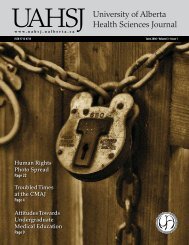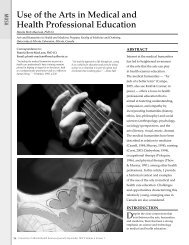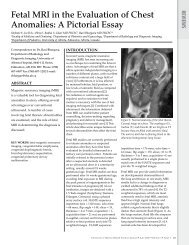REVIEWTable 1: Efficacy <strong>of</strong> typical antipsychotics in treatment <strong>of</strong> DOPStudySampleSize Treatment DoseDuration <strong>of</strong>treatment orfollow-upNumber <strong>of</strong>patients withfull or partialremission (%)Number <strong>of</strong> patientswith no change insymptoms (%)Number <strong>of</strong> patientswith deterioration<strong>of</strong> condition (%)Additional notesHamann and Avnstorp n=11 Pimozide 1-5 mg/day 6 weeks 10 (91 1 (9) 01982 15 n=9 Placebo N/A 4 weeks 1 (9) 0 8 (73) Two lost to follow-up forsenility (n=1) and extensiverelapse (n=1)Ungvari and Vlader n=10 Pimozide 2-8 mg/day 3 weeks 10 (100) 0 01986 13 n=10 Placebo N/A 2 weeks 0 1 (10) 9 (90)Zomer et al. 1998 16 n=18 Pimozide 1-5 mg/day 3-4 weeks 11 (61) 0 7 (39)n=15 None N/A 3 (20) 12 (80) 0Lyell 1983 17 n=66 Pimozide 2-12 mg/day N/A 44 (67) 16 (24) 0 6 lost to follow-upBhatia et al. 2000 18 n=46 Pimozide 4-8 mg/day N/A 40 (87) 0 6 (13)Lindskov andn=14 Pimozide Unknown 19-48 weeksBaadsgaard 1985 19 after termination<strong>of</strong> treatment7 (50) 0 4 (29) Three patients with relapsesbut responded to intermittenttreatmentTable 2: Efficacy <strong>of</strong> atypical antipsychotics in treatment <strong>of</strong> DOPAtypical AntipsychoticTreatmentSampleSizeDoseNumber <strong>of</strong> patientswith full or partialremission (%)Number <strong>of</strong> patientswith no change insymptoms (%)Number <strong>of</strong> patientswith deterioration <strong>of</strong>condition (%)Number <strong>of</strong> patients lostto follow up (%)Risperidone 24-28 41 0.25-5 mg/day 28 (68) 1 (2) 0 7 (29) lost to follow up;4 were switched to otherdrugs for varying reasonsincluding requiring a differentantipsychotic for co-morbidpsychiatric disease, andintolerance <strong>of</strong> risperidone;1 took it once and refused tocontinue medicationOlanzapine 25,26,28 10 2.5-20 mg/day 9 (90) 0 0 1 (10)Quetiapine 27, 28 2 100-150 mg/day 2 (100) 0 0Aripiprazole 30-32 4 10-15 mg/day 3(75) 0 0 1 (25)Paliperidone 33 1 3 mg/day 1 (100) 0 0RLAI 29 1 25-37.5 mg IM 1 (100) 0 0while 3 patients were non-compliant withtreatment. 10 Of note, the sample sizes for theother typical antipsychotic treatments wererelatively small.Atypical AntipsychoticsAtypical antipsychotics differ from typicalantipsychotics in their various mechanisms<strong>of</strong> action and are generally associated withless extrapyramidal symptoms. Meltzer etal. (1989) 20 proposed that a preference for5-HT2A receptor antagonism rather thanDA D2 receptor antagonism distinguishesthis class <strong>of</strong> drugs, although a number <strong>of</strong>other hypotheses question this. 21, 22 Atypicalantipsychotics used in the treatment <strong>of</strong>DP that will be discussed are risperidone,olanzapine, quetiapine, aripiprazole, andpaliperidone (Table 2).A number <strong>of</strong> case series have utilizedrisperidone as the main treatment modalityfor DP. Gallucci and Beard 23 first establishedrisperidone as a potential treatment <strong>of</strong> DP.Overall, <strong>of</strong> the 41 cases <strong>of</strong> DP treated withrisperidone that we reviewed, 28 had a fullor partial remission, one had no change insymptoms and 12 were lost to follow up orwere switched to another drug during thetreatment course – reasons for switchingmedications include co-morbidities thatcould be simultaneously treated withDP using another drug and unspecifiedintolerance <strong>of</strong> risperidone (Table 2). 24-28The most recent and largest retrospectivecase study followed 20 patients utilizingatypical antipsychotics for DP. 26 Fifteenpatients were treated with risperidone asthe main atypical antipsychotic and 10 <strong>of</strong>them had full or partial remission, while 5were lost to follow-up. Five patients weretreated with olanzapine as the main atypical10<strong>University</strong> <strong>of</strong> <strong>Alberta</strong> <strong>Health</strong> <strong>Sciences</strong> <strong>Journal</strong> • April 2012 • Volume 7 • <strong>Issue</strong> 1
antipsychotic. Of these patients, 4 had full orpartial remission, and 1 was lost to follow up.Another case series compared 4 patientstreated with risperidone and onetreated with quetiapine. 27 Three <strong>of</strong> the 4risperidone-treated patients experiencedtotal resolution <strong>of</strong> delusions; one <strong>of</strong> thesethree patients was also on lithium, anotherwas on sertraline and alprazolam as well,and another was also on sertraline anddonepezil. The last risperidone treatedpatient had a decrease in delusions and wason no other medications. The patient treatedwith quetiapine showed partial remissionand was also on venlafaxine, clonazepam,buspirone and bupropion.Shah and Pervez (2009) published onlythe second case report for the use <strong>of</strong>risperidone long-acting injections (RLAI). 29The patient refused to take oral risperidone,but accepted RLAI 25 mg IM every 2 weeks.This dosage was titrated up to 37.5 mg IMon discharge and she then switched to 5mg/day PO risperidone. Her symptomsimproved, although complete remission wasnot achieved.There are also newer atypical antipsychoticswhose efficacy in the treatment <strong>of</strong> DPhas only been documented in a limitednumber <strong>of</strong> case studies. One example isaripiprazole. 30-32 Rocha and Hara (2007)documented the first case <strong>of</strong> aripiprazoletreatment in an 85 year old DP patientand she underwent full remission. 30 Ina subsequent study, 2 patients with DPwere treated with aripiprazole and bothhad complete remission. 31 Paliperidone, anatypical antipsychotic approved by the FDAin 2006, has only been used in one DP case,where an 88 year old man treated with thedrug underwent complete remission. 33DISCUSSIONOur review <strong>of</strong> typical antipsychoticsindicates that pimozide is an effectivetreatment option for DP. The rates <strong>of</strong> fullor partial remission were similar to thenumbers reported in a systematic review byLepping et al. (2007). 10 There have been anumber <strong>of</strong> smaller case reports and studiesutilizing other typical antipsychotics such ashaloperidol, trifluoperazine, flupenthixol andfluphenazine depot, all <strong>of</strong> which showedexcellent rates <strong>of</strong> full or partial remission. 10Despite the past successes <strong>of</strong> pimozide, it isno longer considered first-line treatment <strong>of</strong>DP, due to the advent <strong>of</strong> the safer atypicalantipsychotics. 34Furthermore, the long-term use <strong>of</strong> pimozideis associated with a number <strong>of</strong> adverseside effects. Extrapyramidal symptomssuch as tardive dyskinesia, parkinsonismand akathisia occur in less than 10-15%<strong>of</strong> patients treated with pimozide forschizophrenia, and Gilles de la TouretteSyndrome. 11 It has also been associatedwith clinically significant QT cintervalprolongation, including Torsades de Pointes,possibly due to the calcium channelblocking effects <strong>of</strong> the drug. 7, 14, 35 These sideeffects, especially its cardiac effects anddrug interactions (drugs metabolized bycytochrome P450 isoenzyme 3A4), makepimozide a non-ideal DP therapy. 34Much less is known about atypicalantipsychotics, because <strong>of</strong> their relativelyrecent introduction compared to typicalantipsychotics. The largest review to date<strong>of</strong> atypical antipsychotic use in DP wasconducted in 2008 by Freudenmann andLepping, 34 which concluded that atypicalantipsychotics should be the first linetherapy for DP.The atypical antipsychotics with the largestsample sizes in our review were risperidoneand olanzapine. Risperidone has beenestablished as the most common atypicalantipsychotic used in the treatment <strong>of</strong> DP.The particular effectiveness <strong>of</strong> this drug hasbeen linked to its high affinity for 5-HT 2receptors, a receptor which has been linkedto psychotic processes and perceptualdifferences. 12 Although risperidone’sside effect pr<strong>of</strong>ile is superior to that <strong>of</strong>typical antipsychotics, there are instanceswhere parkinsonism and akathisia havebeen produced by its use and it has beenassociated with a mild increase in metabolicsyndrome. 32 An added benefit <strong>of</strong> risperidoneis that it is the only atypical antipsychoticavailable as a long-acting depot. Long actinginjections are particularly useful in patientswho are demonstrating harmful behavioursand refusing to comply with oral treatment.The goal <strong>of</strong> such a treatment would beto help the patient accept their problemis psychological and thus comply withoral therapy.Olanzapine is the second most commonatypical antipsychotic used in DPtreatment. 34 Its side effect pr<strong>of</strong>ile is alsosuperior to that <strong>of</strong> pimozide and it rarelycauses extrapyramidal syndrome. However,this medication is closely associated withmetabolic syndrome and sedation. 32 Its useis still limited by a smaller body <strong>of</strong> evidence,but the fact that three patients treated withrisperidone were switched to olanzapinedue to intolerance suggests it may be a moretolerable drug. 25Quetiapine had an excellent remission rate,but with a small sample size (n=2), morestudies must be done in order to assess itsuse in the treatment <strong>of</strong> DP. Freudenmannand Lepping (2008) found a full or partialremission rate <strong>of</strong> 88% after reviewing 8cases. 34 The side effect pr<strong>of</strong>ile <strong>of</strong> quetiapineis generally limited to drowsiness, dizzinessand postural hypotension, with minimalrisk <strong>of</strong> extrapyramidal symptoms or adversecardiac effects. 36 Quetiapine’s excellentside effect pr<strong>of</strong>ile combined with its highremission rate makes it a potential treatmentfor DP.The results <strong>of</strong> aripiprazole treatment in DPhave only been published for 4 patients todate with all 4 demonstrating full or partialremission. 23-25 There have not been anyrandomized control trials or placebo crossover studies performed with aripiprazoleand DP, but the case study results arepromising. Adverse effects <strong>of</strong> aripiprazoleinclude nausea and akathisia, but it is nonsedatingand less <strong>of</strong>ten associated withextrapyramidal symptoms and metabolicdisturbances. 37 This excellent side effectpr<strong>of</strong>ile may make it beneficial to DP patientswho cannot tolerate the side effects <strong>of</strong>other antipsychotics.Paliperidone is the latest atypicalantipsychotic used in the treatment <strong>of</strong> DP.Paliperidone is the main active metabolite<strong>of</strong> risperidone and it blocks 5-HT 2Aand D 2-receptors. It has a long half-life <strong>of</strong> 24 hours,which decreases the number <strong>of</strong> daily doses.As well, it decreases the risk <strong>of</strong> any potentialadverse drug reactions, which is especiallyimportant because many DP patients havenumerous co-morbidities being treatedsimultaneously. 33 The clinical efficacy <strong>of</strong>paliperidone as a treatment for DP needsto be confirmed by further case studies orrandomized control trials.CLINICAL IMPLICATIONSDiagnosis <strong>of</strong> DP is definitely within thescope <strong>of</strong> a dermatology practice. However,the psychological basis <strong>of</strong> the disordermakes initiating therapy in a dermatologist<strong>of</strong>fice challenging. Patients <strong>of</strong>ten feel asif their symptoms are not being seriouslyconsidered when the dermatologist triesto explain that the disease is psychotic innature. Referral to a psychiatrist is <strong>of</strong>tenmet with anger and frustration, resultingin the patient either seeking the opinion<strong>of</strong> another dermatologist or resorting toself-treatment, which may be potentiallyharmful. 10 It may be prudent to ask thepatient’s thoughts on you consulting anexpert colleague who deals with similarconditions more frequently. This will openthe door to discussing the managementplan with a psychiatrist, while empoweringthe patient to be actively involved in thetreatment decision.REVIEW<strong>University</strong> <strong>of</strong> <strong>Alberta</strong> <strong>Health</strong> <strong>Sciences</strong> <strong>Journal</strong> • April 2012 • Volume 7 • <strong>Issue</strong> 1 11






